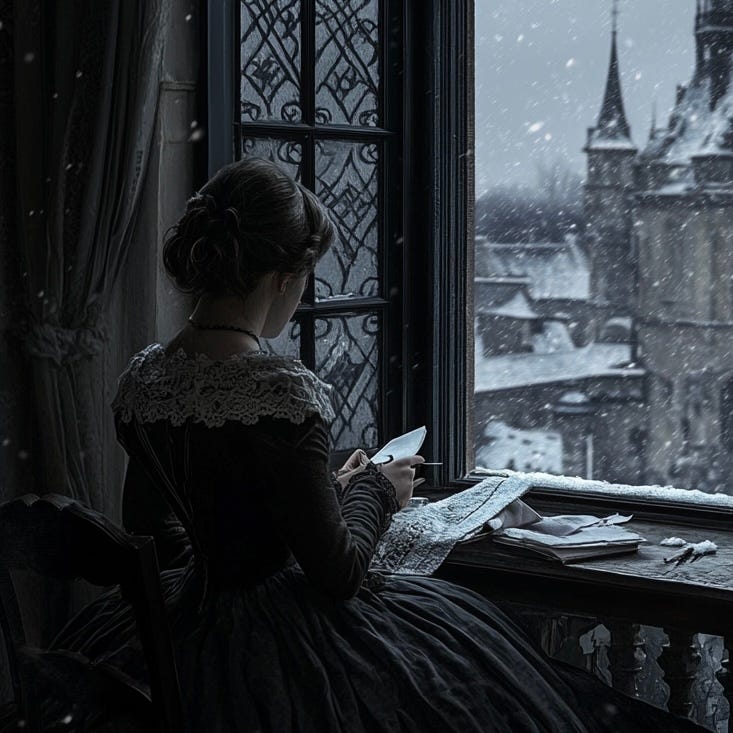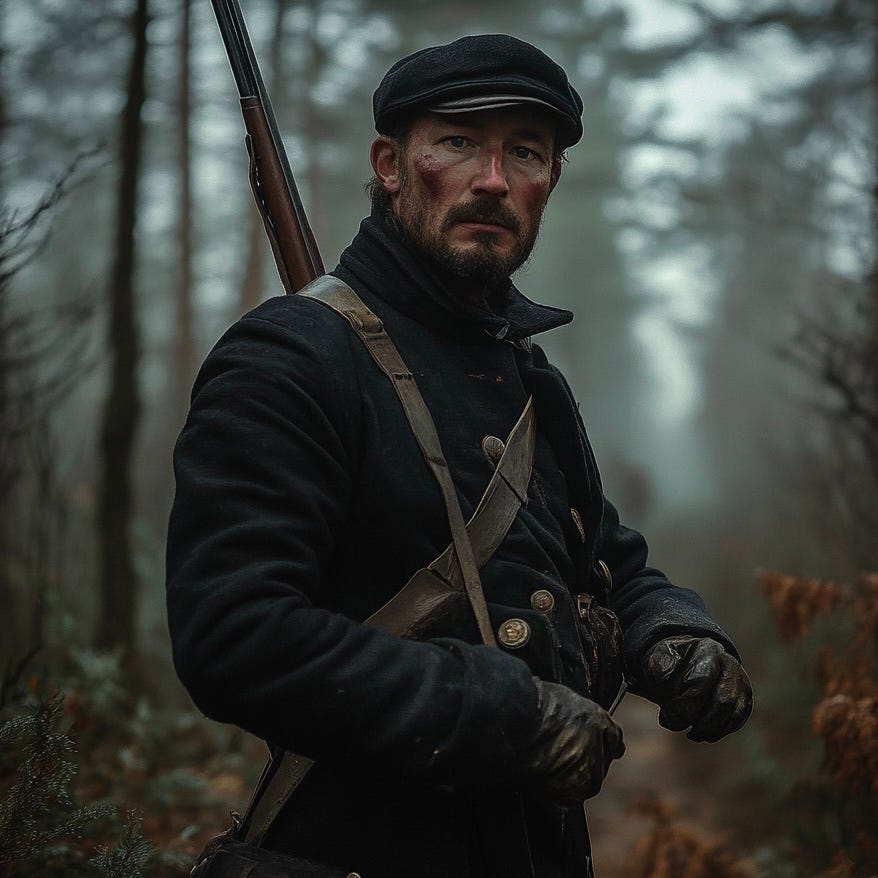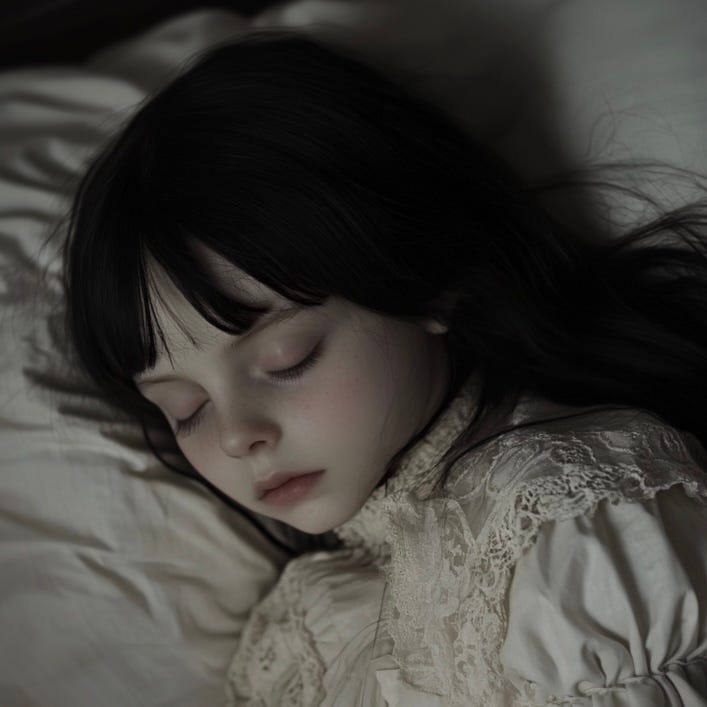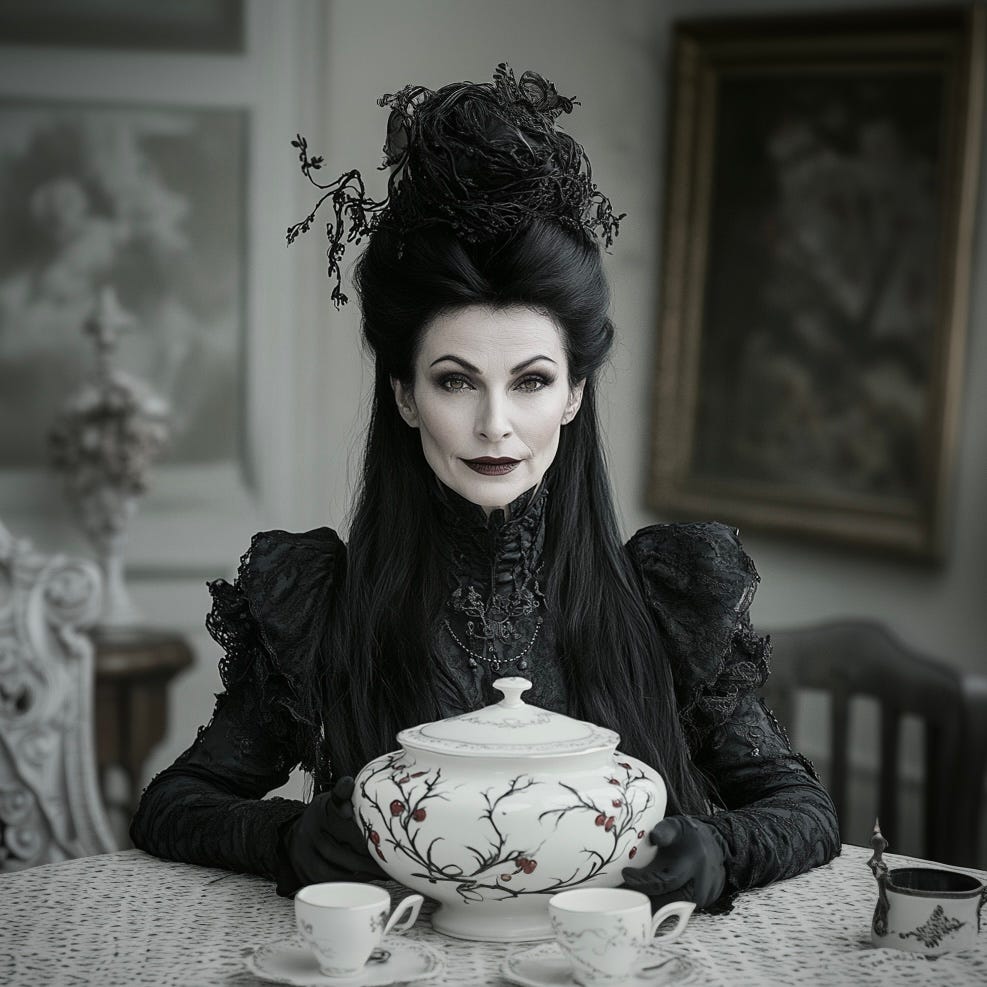Little Snow White: Part 1
A Fairy Tale
“Schneewittchen” was number 53 in the 1812 edition of Kinder- und Hausmärchen (Children’s and Household Tales) of the Brothers Grimm. Marie Magdalene Elisabeth Hassenpflug of Hesse-Darmstadt was said to be the Grimms’ source of this other famous tales, such as Little Red Riding Hood and Sleeping Beauty.1 The word “Schneewittchen” is a combination of the Low German “Sneewittchen” and the High German “Schneeweißchen,” both of which mean “Little Snow White”; because the main character is a seven-year-old girl, who is about the same height as the seven dwarfs (a detail often lost or wilfully ignored in modern adaptations).
The numbers 3 and 7 (aside from their numerological significance) are important in the story. Little Snow White is seven years old. She seeks refuge with seven dwarfs, who live beyond seven hills. Her birth mother makes a wish over three drops of blood, asking for a child who is (i.) as white as snow, (ii.) as red as blood, and (iii.) as black as the window frame.2 The wicked queen uses three disguises (peddler, pauper, peasant) and tries to kill Little Snow White with the three weapons (tight staylaces, a poisoned comb, and an apple that is half red and half white). The weapons are chiastically alluded to near the end when the dwarfs (thinking her dead) lay her out in a glass coffin and (i.) unloose her stay laces, (ii.) comb her hair, and (iii.) wash her body in white water and red wine.
The German word for “dwarf” is Zwerg (pl. Zwerge) and refers—as in English—to both little people and a class of fairy-tale beings. It derives from the Middle Low German dwerch and Old High German twerch, both of which are related to the Old English dweorg, which later became “dwarf.” J.R.R. Tolkien invented the plural “dwarves” and later admitted this was a grammatical error on his part. But by the time he came round to admitting his mistake, The Hobbit and the Lord of the Rings trilogy had taken on a life of their own and he could not go back and make changes to the canon without upsetting his fans. Thus, the plural “dwarves” (unlike “Hobbit”) never made it into the Oxford English Dictionary (OED), which Tolkien not only contributed to but for which he was the primary author for the headword “dwarf.”3 Other than their scaled-down stature, the physical characteristics of the dwarfs in “Little Snow White” are not described. In many illustrated Biedermeier editions of Grimms’ fairy tales the dwarfs are depicted as looking somewhat like modern garden gnomes. And it is worth noting that, in German, these topiary decorations are called Gartenzwerge (garden dwarfs), not Gartengnomen (garden gnomes).
The following is a reimagining of “Little Snow White” based on the version of the story as it appeared in the 1812 edition of the tales. However, I have placed “fairyland” in a late nineteenth-century (vaguely Bavarian) context and added surrealist elements inspired by the works of Laura Esquivel, Italo Calvino, Isak Dinesen, and Gabriel García Márquez. But I have stuck to the original sequence of events and retained the macabre details, such as the wicked queen’s desire to eat Little Snow White’s lungs and liver. I have produced a new translation of all the poems, to include the famous couplet “Mirror, mirror on the wall,” since the magic mirror is also supposed to be diminutive: “Spieglein, Spieglein an der Wand” means “Little mirror, little mirror on the wall.”
Little Snow White: Part 1
Once upon a winter’s day, when the snowflakes fell like feathers from the pewter sky, a young queen sat before the open window of her sewing room. A boreal landscape of sugary white hills stretched before her on the work-table, where the silk threads wound round the upright bobbins had grown brittle with frost. She was embroidering the hem of what she had hoped would be her child’s baptismal gown, but which, over the years, had become how own burial shroud.
The snow passed through the black-framed window, and (wind-whipped) whirled round the unlit chamber behind her, where it landed in white curlicues on the patterned whorls woven into the Persian rug. On the damp, curling wallpaper hung a painting of the Virgin Mother cradling a crowned Christkindl; and the paint cracked under the combined influence of the freezing gusts and the snaky hoarfrost creeping from the gilt-edged frame to the fast-fading Madonna at its center.
Thus, is my unlaboring womb as barren, cold, and unfruitful as this dead winter’s day, the queen lamented. The sound of a train whistle shrilled in the distance, startling her from her reverie and causing her (callously) to prick with a cruel, crewel needle her pale, uncallused snow-white thumb. Three drops of blood drops fell on the ice-stiffened pristine cloth; and the queen closed her eyes and said, “If only I had a child as red as blood, as white as snow, and as black as the wood of the window frame.”
Three days later, she immaculately conceived; and, three days after that, brought forth a daughter as red as blood, as white as snow, and with hair as black as ebony. The child was named Little Snow White; and no sooner was she born than the young queen died; and her wintry corpse was wound up in the treble-blood-stained winding sheet into which she had poured her empty life.
For a year, the king grieved. Then he married a woman of surpassing beauty.
But the new queen was hochnäsig (nose always in the air), and so vain that she could not bear the sight of anyone more beautiful than she. Often, she sat in her boudoir, with the instruments of her cosmetic witchcraft on the dressing table before her (oils and unguents, powders and paints). And ever and anon (though not always at such times), she would pick up her bronze-handled mirror, and say:
“Little mirror, in my hand, who’s the fairest in the land?”
And the mirror would answer, “You’re the fairest in the land,” which pleased the queen to no end. For she knew that the magic mirror could not lie.
In the meantime, Little Snow White began to grow; and, by the time she turned seven years old (on a bright winter’s morning), she had become as beautiful and radiant as a summer afternoon. And on that selfsame seventh birthday, the proud queen picked up her magic mirror and said, “Little mirror in my hand, who’s the fairest in the land?”
And the mirror replied:
“Your beauty on Earth is surpassed by few. But Little Snow White is fairer than you.”
Speechless, the queen gently laid the magic mirror down. She began to pluck her eyebrows; and, withdrawing deeper into herself, applied (in a distracted and automatic fashion) her foundation; but even her enchanted creams could not conceal the green envy that suffused her smooth and unblemished skin.
A thicket of thorn brushes sprouted up in her heart, where charity and warmth had never dwelt. And from that moment on, the queen’s hatred for Little Snow White knew no bounds. Whenever the girl came into the room, the queen rummaged through her reticule; or, turning away with a sour face, contemplated any object but the hated one before her.
By spring, the situation had become insufferable, so she summoned the hunt master. “Herr Jägermeister, I command you to take Little Snow White into the forest. I never want to see her again. Kill her, and bring me her lungs and liver as proof that she is dead.”
The next morning, Little Snow White allowed the hunt master to take her delicate alabaster hand into his gloved one. He led her out of the castle and over the seven hills. At midday, they were deep inside the forest. The hunt master unslung his rifle and propped it against a tree. He drew a skinning knife from his scabbard, and, spitting on the ground, walked toward the girl.
He was about to butcher Little Snow White, when the child wept and said, “Oh, Herr Jägermeister, please don’t kill me! I promise I’ll stay in the forest; and I’ll never go home again.”
Because she was so beautiful, the hunt master relented, saying, “You’re free to go, little one.” But even as he said this, he thought, The wild beasts will devour you by sundown. But what has that to do with me?—Yet, he knew he could not return to the queen without the grisly trophies she had demanded. So he looked this way and that; and, seeing a young boar entering the clearing, killed it, gutted it, and removed the lungs and liver, stuffing these into his haversack. The girl gaped in horror at the mutilated carcass.
Shouldering his rifle and taking one last look at the girl, the hunt master turned round and wandered off, whistling to the wind as he walked back in the direction of the seven hills. Soon, he was in the presence of the queen and exhibited to her the boar’s organs as proof that he had done as she had bade. The queen told the him to take the haversack to the kitchen. Then she rewarded him for his pains.
Meanwhile, the girl plunged deeper into the forest, scraping her skin against the sharp branches, and whimpering out of fear for the rustling of the foliage and the snapping and crackling of the twigs and bracken. Kites flew overhead, as snarling beasts ran on either side of her—stoking her anxiety even more. But what she did not know was that they were keeping watch over her, because all the woodland creatures loved Little Snow White.
Late in the afternoon, she glimpsed in the middle distance an ivy-clad cottage. Traipsing up the cobbled path that led to its entrance, she came to the outer door, which she unlatched. It was constructed in such a way that the upper half remained fixed as the lower half swung open. She entered and gasped. Everything inside was tiny, dainty, and neat; much like Little Snow White.
A round wooden table, covered in a white cloth, dominated the center of the room. There were seven small plates spaced evenly around its circumference. Seven spoons, seven forks, seven knives—all these tiny utensils were arranged in precise positions with respect to each plate. There were seven crusts of bread, seven vegetables, and seven earthen cups filled with red wine. In a row against the wall were ranged seven small beds covered in sheets as white as snow.
Lying pell-mell about in bags and open caskets were nuggets of gold and silver; and smoky, uncut diamonds. These did not interest her in the least.
She was very hungry and ate the bread and vegetables, using each plate at least once. She took a swig of wine out of each cup, but drained one to its dregs. When she had finished her repast, she was so tired that she tried out each of the seven beds before finding one that suited her just right. But before climbing into it, she knelt before it and said her prayers; and, by the time her head hit the pillow, Little Snow White was asleep.
At sundown, the owners of the cottage returned. They were seven dwarfs who mined precious minerals in the caverns of a lofty mountain close by. They entered the cottage and lit seven tiny candles. They saw immediately that someone had been there, because everything had been disturbed. Everything, that is, except the gold, silver, and diamonds.
“Someone’s been sitting in my chair,” said the first dwarf.
“Who’s been eating off my plate?” asked the second.
“I imagine that whoever ate from your plate,” the third dwarf said, “is the same one who devoured my crust of bread—”
“AND my vegetables!” groused the fourth.
“Well, the culprit obviously did it with my fork!” fumed the fifth.
”And with my knife,” the sixth sighed.
“Look,” the seventh sneered. “My cup of wine is empty!”
By then, the first dwarf had gone over to his bed. On the eiderdown mattress was the impress where a small burden had lain. “Someone’s been lying in my bed!” he shouted.
The other six dwarfs ran to their own beds “Mine too!”
But the seventh dwarf had discovered Little Snow White in his bed. He quietly gestured for the others to join him. The seven dwarfs surrounded the little girl; and their seven tiny candles shed their light on the girl. In unison, the seven dwarfs whispered, “Oh my Lord, what a beautiful child this is.”
They were so taken by the angelic girl before them that they could not bear the thought of waking her. So they decided that they would go to sleep and have the seventh dwarf (whose bed Little Snow White was occupying) spend an hour in each of his companions’ beds until the nocturnal cycle had run its course and each of the seven dwarfs had kept watch for an hour—with the seventh dwarf (having slept six hours in six separate beds) keeping the final watch.
The next morning, when Little Snow White opened her eyes, the sudden appearance of the seven smiling dwarfs standing shyly round the bed startled her. But she could sense that they were friendly.
“What is your name?” they asked.
“Little Snow White.”
“What brought you to our cottage?”
The girl told them of her tribulations; and how her stepmother the queen had ordered the hunt master to kill her; but the man changed his mind and spared her life. “Then I walked through the woods until I found your cottage.”
The first dwarf said, “If you’ll do all the household chores—”
And the others chimed in:
“The cooking!”
“The cleaning!”
“The turning of the sheets!”
“The knitting!”
“The sewing!”
“And other household feats!—”
“AS I SAID!” the first dwarf interjected, stomping his foot on the floorboards and wagging his little index finger in the air. “If you do all the household chores, we will let you stay here. And you will always be provided for.”
“I would like that very much,” replied Little Snow White.
So the seven dwarfs built an eighth bed; and Little Snow White stayed in the cottage and kept it cosy and clean. Each day at the crack of dawn, the seven dwarfs went up into the mountain to mine for precious stones, taking with them their pickaxes and spades. By the time they returned near sundown, a scrumptious supper was waiting for them on the table.
During those long convivial nights, as the dwarfs smoked their pipes and chatted amiably among themselves and with their new friend, they repeatedly cautioned Little Snow White: “Your stepmother will soon find out you’re here. So when we are away and you are all alone in the cottage, you mustn’t let anyone in.”
The morning after Little Snow White’s disappearance, the wicked queen sat at the breakfast table opposite the king, who was reading the morning paper. As the minutes ticked away on the mantel clock, the queen stared unblinkingly at the fool she had married.
The king folded the newspaper and glanced out the window. He removed his pince-nez and, massaging the bridge of his nose, said, “Have you seen Little Snow White?”
“Don’t you recall, my love? You sent her to a boarding school in a land far, far away.”
“Ah,” the king nodded, as the kitchen door swung open.
The cook emerged, carrying a snow-white tureen of Dresden porcelain, decorated with bright-red berries and jet-black vines. She placed it on the table before the queen. “Madame, it is as you requested. The lungs and liver have been boiled in brine.”
“Excellent,” the queen replied, grinning like an adder.
Many of these fairy tales appeared in Charles Perrault’s 1697 collection Histoires ou contes du temps passé, avec des moralités (Stories of Times Past, with Morals). And it is possible that Marie Magdalene’s mother, who was a Huguenot, related them to her in French.
This motif of a mother praying to give birth to a child who is as red as blood and white as snow occurs in the darkest of the Grimms’ children’s tales, “The Juniper Tree.”
The Ring of Words: Tolkien and the Oxford English Dictionary by Peter Gilliver, Jeremy Marshall, and Edmund Weiner is a fascinating survey of Tolkien’s scholarly endeavors and contributions to the OED. It is rigorously researched and delves into his work on Medieval English, Germanic, and Scandinavian languages. The section concerning “dwarves” can be found on pages 104–108.











I'm really enjoying these retellings of yours!
Loooooveeee....